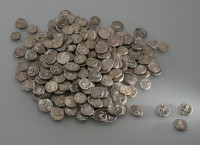 A hoard of almost 300 silver Celtic coins has been unearthed in the village of Füllinsdorf, near Basel in northwest Switzerland. They were found by a private individual who was working as a scout for the canton archaeological department. He recovered a number of coins that were just barely buried in a few centimeters of soil, and then he alerted the official archaeologist. They found the 293 silver coins spread over an area of about 538 square feet, all of them just under the surface. It’s by far the largest number of Celtic coins ever found in Switzerland.
A hoard of almost 300 silver Celtic coins has been unearthed in the village of Füllinsdorf, near Basel in northwest Switzerland. They were found by a private individual who was working as a scout for the canton archaeological department. He recovered a number of coins that were just barely buried in a few centimeters of soil, and then he alerted the official archaeologist. They found the 293 silver coins spread over an area of about 538 square feet, all of them just under the surface. It’s by far the largest number of Celtic coins ever found in Switzerland.
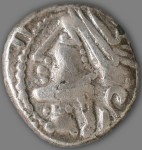 The coins are of a type known as a quinarius, a small silver piece worth half of a denarius. When Rome first issued the denomination in 211 B.C., it was called a quinarius because it was worth five asses (the equivalent of 5 pounds in brass coin). When they were reissued in 101 B.C., they were still worth half a denarius, but monetary reform made the denarius worth 16 asses so the quinarii were now worth eight.
The coins are of a type known as a quinarius, a small silver piece worth half of a denarius. When Rome first issued the denomination in 211 B.C., it was called a quinarius because it was worth five asses (the equivalent of 5 pounds in brass coin). When they were reissued in 101 B.C., they were still worth half a denarius, but monetary reform made the denarius worth 16 asses so the quinarii were now worth eight.
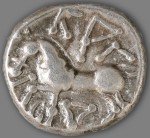 The Celts used Roman coinage as a model, but they modified the particulars. Their coins are smaller, just a centimeter in diameter and two grams in weight. Roman quinarii had a helmeted figure of Pallas, later Victory, on the obverse, and the Dioscuri (divine twins Castor and Pollux) on horseback on the reverse.
The Celts used Roman coinage as a model, but they modified the particulars. Their coins are smaller, just a centimeter in diameter and two grams in weight. Roman quinarii had a helmeted figure of Pallas, later Victory, on the obverse, and the Dioscuri (divine twins Castor and Pollux) on horseback on the reverse. 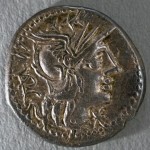 The Celtic version also has a helmeted victory on the obverse, but done in Celtic style and a single Celtic horse on the reverse. They also had a name on the reverse written in Greek: KAΛETEΔOY, or Kaletedou in the Latin alphabet. There are two different types of quinarii in the hoard, one earlier, one later, and both of them bear Kaletedou’s name.
The Celtic version also has a helmeted victory on the obverse, but done in Celtic style and a single Celtic horse on the reverse. They also had a name on the reverse written in Greek: KAΛETEΔOY, or Kaletedou in the Latin alphabet. There are two different types of quinarii in the hoard, one earlier, one later, and both of them bear Kaletedou’s name. 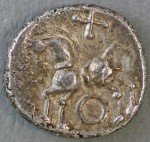 We don’t know who or what it represents, but archaeologists believe it’s a personal name, probably belonging to a Gallic chieftain.
We don’t know who or what it represents, but archaeologists believe it’s a personal name, probably belonging to a Gallic chieftain.
Canton archaeologists believe the coins were buried around 80-70 B.C. Although they were found scattered, they were probably initially buried together by someone looking to hide them in a secure location. There is no archaeological evidence of a settlement or structure anywhere near the find site. Celts did habitually bury treasure for safekeeping, sometimes near a sanctuary so a deity would be standing guard.
We don’t know what the purchasing power of bronze, silver and gold coins in the area was at that time, but evidence suggests that the money economy was more the province of urban centers than of the farming villages and semi-urban settlements that most of the local Celtic tribes (in the Füllinsdorf area that would have been the Rauraci, a client tribe of the Helvetii) lived in. Intra-regional and international trade with the Mediterranean peoples was well-established in the area by the first century B.C.
After 80 B.C., trade declined, disrupted by local wars between tribal leaders, pressure from Germanic peoples and by the encroaching forces of Rome. The population began to leave sparsely settled areas for the safety of fortified towns. Under increasing strain, in 61 B.C. the Helvetii, in collaboration with other Celtic tribes in what is now Switzerland, planned a mass migration to the Atlantic coast of France. Julius Caesar stopped them. They were his first victory in the Gallic Wars.
The Celtic treasure of Füllinsdorf is on display at the canton museum from March 31 to September 23.